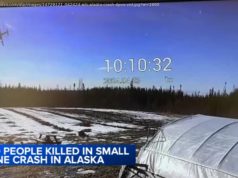Boston’s streets were flooded with icy stormwaters.
This week is ending with almost the entire East Coast being covered in a sheet of snow. A large, rapidly intensifying winter storm that began on Wednesday dumped over a foot of snow in New England, but also brought with it damaging winds, and dangerous, icy, coastal flooding.
The city of Boston, according to the National Weather Service, also broke a record for its high tide, the result of the storm’s winds pushing an already high tide further onshore.
It all started Wednesday, when most of the coast was under a winter storm watch or warning. It was the last thing East Coasters wanted after enduring one of the coldest holiday seasons on record.
Even Florida was experiencing weirdly cold weather, with a freeze watch or warning in place for much of the state (leading to weird things like near-frozen iguanas dropping from trees). The light dusting of snow then brought some Florida cities to a standstill since they don’t have snow removal equipment or ice trucks. (Check out all the watches and warnings for each county here .)
As the storm crawled up the East Coast, it experienced a rapid drop in pressure, and grew intense, quickly. At its peak, the storm resembled something like a hurricane: a “bomb cyclone” spinning around a central eye.
The storm was a “textbook” example of a winter cyclone, Jeff Frame, an atmospheric scientist at University of Illinois at Urbana-Champaign said. In satellite photos, you can even see the system pulling up warmer air from the tropics, as well as the system circulating colder air coming down from the arctic. Storms like this, he says, serve an important function as they help redistribute pockets of heat and cold more evenly around the globe.
But the consequence of all that movement was a lot of cold moisture for those on the ground. Boston saw a foot of snow, and downtown streets were flooded with ice-capped waters. Twenty thousand people in Massachusetts lost power.
New York saw around half of a foot of snow in some place. Accumulations decrease the further South you travel, but even Virginia Beach saw blizzard conditions. Though Southern cities like Charleston, South Carolina, and Savannah, Georgia, only got a few inches of snow and freezing rain, it quickly turned to a dangerous situation on roadways.
Two notable things are happening right now that created this storm.
The first is that it’s intensely, oddly cold in the Eastern United States.
Here’s a map modeling the average temperature anomaly (how far temperatures are from average, around the world, for this time of year). Overall, the world is 0.5 degrees Celsius warmer than average (thanks, climate change!). But parts of the East Coast of the United States are 10 degrees below normal.
This strange weather pattern has been with us for more than a week.
As Mashable’s Andrew Freeman explains, we can blame a northward shift in the jet stream in the Northern Pacific around Alaska. The Arctic jet stream is an area of fast-moving wind high in the atmosphere that acts as a barrier between regions of cold and warmer air.
The northward surge in the jet stream around Alaska means temperatures are actually warmer there than normal. This movement then caused another section of the jet stream to dip into the Eastern US, bringing with it freezing air from around Hudson Bay. Brrr.
The second factor is that a “bomb cyclone” formed off the East Coast of the United States.
As Vox’s Jen Kirby explains, it means there’s a weather system dropping pressure very, very quickly. When pressure drops, storms intensify and spin counterclockwise (a.k.a. form a cyclone). The drop in pressure is due, in part, to the strong differences in temperature between the warmer Gulf Stream in the Atlantic and the frigid temperatures on land.
“When you have this really tight temperature gradient, you can get these pieces of energy — weather disturbances — coming through the atmosphere,” meteorologist Ed Vallee explained to Kirby. (Check out their interview for a great explanation of this “bomb cyclone” here .)
CNN reports that 11 people have already died in the outbreak of winter cold throughout the country in the past few weeks (not counting this blizzard). So it’s important to stress: Winter weather is very, very dangerous. Cold temperatures and high winds are a recipe for frostbite and hypothermia. Hospitals routinely see an uptick in admissions for cold-related symptoms and heart problems in the days after a snowstorm. And then there’s traffic: About 800 people die in cold-weather related traffic accidents every year.
So as we go further into the winter months: Stay warm, stay off the roads when they’re icy, and stay safe.






